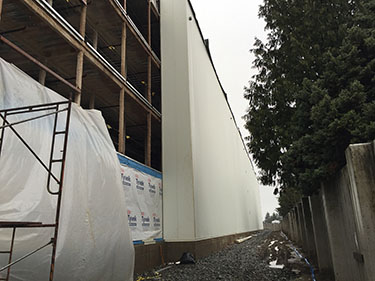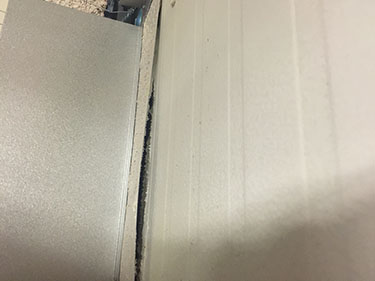|
Subscribe / Renew |
|
|
Contact Us |
|
| ► Subscribe to our Free Weekly Newsletter | |
| home | Welcome, sign in or click here to subscribe. | login |
Architecture & Engineering
| |
 |
November 29, 2018
Using insulated metal panels? It’s all in the details
Special to the Journal

Zuger-Cheney
|

Ittner
|
Insulated metal panels (IMPs) are an exterior cladding system that can be used on virtually any type of facility and are commonly found on industrial-type structures such as storage buildings or warehouses.
IMPs offer design and construction teams numerous benefits, such as quick installation, advanced thermal performance and a tight, continuous air/weather barrier. This continuous insulation, which meets the 2015 Washington State Energy Code requirements, also helps minimize heating and cooling costs.
To ensure the building envelope performs properly in structures that incorporate IMPs, designers need to pay close attention to how the IMP system interfaces with adjacent envelope and structural systems to achieve optimal performance. When working with building owners and designers, Nexus bec Inc. focuses on avoiding thermal bridging, selecting the right sealants and correctly sealing penetrations through the IMP system. When these details are specifically addressed, owners can get the most out of this efficient and cost-effective system.
Avoid thermal bridging
Thermal bridging occurs when a material that is more conductive than the materials around it spans continuously from the exterior of a wall assembly to the interior of a wall assembly, effectively creating a bridge through the thermal barrier of the wall that allows for the accelerated flow of heat. This frequently occurs at wall studs and is commonly visible on cold days where framing appears to be “shadowed” on the exterior face of walls.
Any structure is susceptible to thermal bridging, but it is a specific concern with metal-framed structures. The biggest concern is thermal bridging will allow for condensation to occur within a wall assembly or on structural members, frequently resulting in deterioration and organic growth within insulation and on gypsum sheathing.
From an energy-efficiency standpoint, thermal bridging has a significant negative impact on the effectiveness of the building’s insulation. For example, metal-framed walls with only batt insulation can see a reduced effectiveness of the insulation of up to 63 percent due to thermal bridging.
Advances in IMP construction and detailing, particularly in sealing at panel joints, have helped remedy this issue. This exterior cladding system itself is designed to avoid thermal bridging; however, it is still possible to find IMP systems that do not properly address this concern due to insufficient joint detailing, improper roof-to-wall transitions, and transitions from IMPs to other adjacent materials.
Generally, IMP packages are designed as a complete system, but often project-specific details for transitions are left to the general contractor to determine in the field if not properly captured during design. Design-build projects are most susceptible to “gaps” in the details. For this reason, it is important to pay close attention to joint detailing and how well the IMP details allow for integration with adjacent materials when selecting a system.
Selecting sealants
Sealants and self-adhered membranes are a critical component in any IMP system and the role it plays as part of the whole building air barrier. The exterior metal face on the IMP will naturally expand and contract with changes in exterior temperature throughout the seasons or even over the course of a day. This thermal expansion may cause panels to bow and shift, putting tremendous strain on sealant joints, both adhesively and cohesively.
It is crucial the design team specify sealants or self-adhered membranes that provide durability, flexibility and exceptional elongation properties over the life of the IMP system.
When specifying a sealant, design teams must consider the regional and specific micro-climate around the building, taking into account solar exposure of the panels, wind exposure and potential sources of humidity that may impact both the installation and long-term performance of the sealant.
Considerations beyond climatic conditions potentially affecting the sealant and air-barrier performance are structural movement anticipated (i.e. high wind exposure) and the intended use of the building where excessive temperature and humidity may be present on the interior.
These types of conditions may further concentrate performance issues on the sealant joints, which are the most dynamic part of the IMP system. It is important to consult with the IMP manufacturer to make sure the sealant specified has proper adhesion qualities for the intended use, followed with an adhesion test to ASTM standards.
Seal from air and water
Every building will have some sort of punched opening, such as windows and doors. It is essential these openings, along with the transitions from slab/foundation to walls, walls-to-roof assemblies and other penetrations (louvers, vents, electrical junction boxes, security cameras, etc.) are properly detailed to ensure a proper seal for air and water.
The redundancy and layering of built wall systems do not exist in the barrier-type system of an IMP, particularly leaving penetrations exposed to climatic conditions. Since many IMP manufacturers often provide full installation details for their systems, it is easy to overlook these critical, project-specific details. For this reason, the design team needs to work collaboratively with the contractor and perform specific site visits during construction to verify the integrity and quality of installation and detailing in the field.
Achieving energy efficiency
Insulated metal panels are an effective and efficient way to clad a building that not only meets state and local energy code requirements, but also provides building owners with a facility that is air- and water-tight. However, these systems are not perfect and require special attention to the unique design issues outlined above.
With so many factors to consider, Nexus works closely with designers, construction teams and building owners to ensure the components of an IMP system are properly selected, detailed and installed.
Dani Ittner is an architect, building envelope designer and principal for Tacoma-based Nexus bec Inc., a building envelope consulting, testing and forensics firm. Nichole Zuger-Cheney is a communication specialist for Tairis Marketing Group. She has more than 10 years of experience working in marketing and communications for local AEC firms.
Other Stories:
- New stage for business development: sets, costumes, humor
- Survey: Sundberg Kennedy Ly-Au Young Architects
- Survey: Freiheit Architecture
- Survey: ZGF Architects
- Survey: BergerABAM
- Survey: PCS Structural Solutions
- East meets West: Planning lessons learned from China
- Here’s South Lake Union’s newest innovation hub
- What happens when big tech moves into small cities?
- 10 things to know about nonprofit housing developers
- Is modular the answer to affordable housing?
- Dialysis with a view: new clinics bring in nature
- Developers must ponder this: Save or scrape?
- Survey: Weber Thompson




